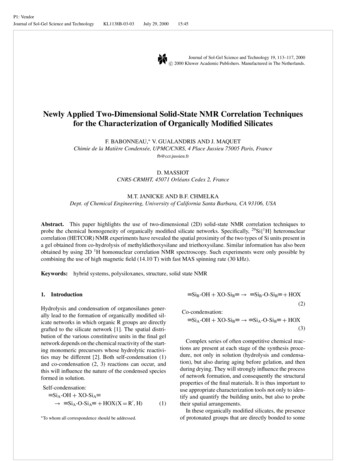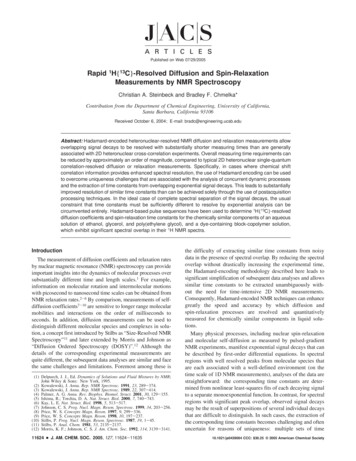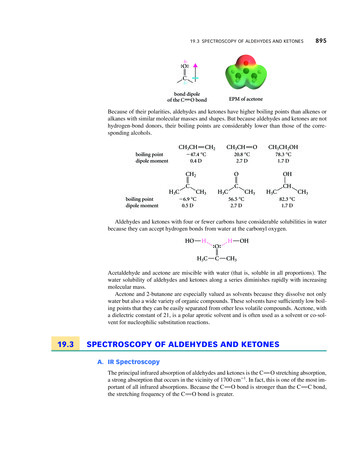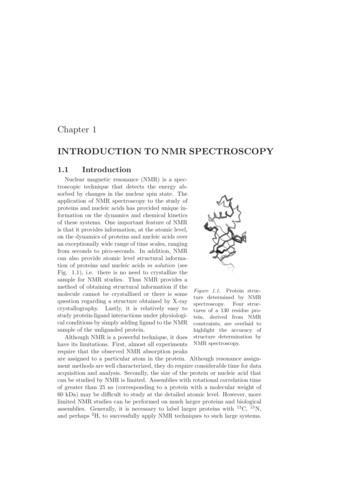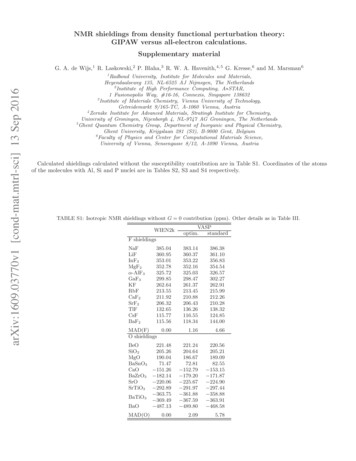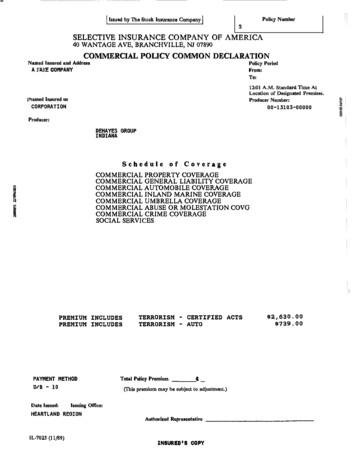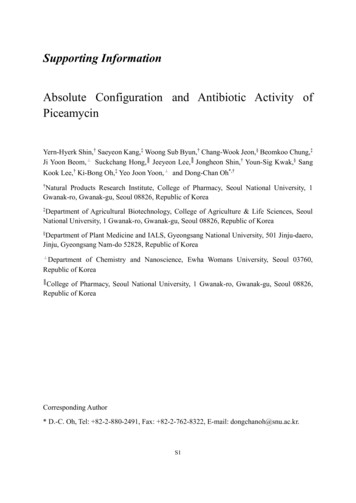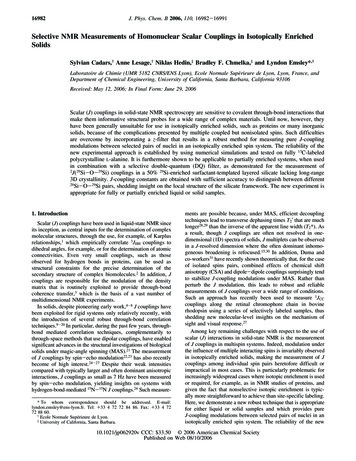
Transcription
16982J. Phys. Chem. B 2006, 110, 16982-16991Selective NMR Measurements of Homonuclear Scalar Couplings in Isotopically EnrichedSolidsSylvian Cadars,† Anne Lesage,† Niklas Hedin,‡ Bradley F. Chmelka,‡ and Lyndon Emsley*,†Laboratoire de Chimie (UMR 5182 CNRS/ENS Lyon), Ecole Normale Supérieure de Lyon, Lyon, France, andDepartment of Chemical Engineering, UniVersity of California, Santa Barbara, California 93106ReceiVed: May 12, 2006; In Final Form: June 29, 2006Scalar (J) couplings in solid-state NMR spectroscopy are sensitive to covalent through-bond interactions thatmake them informative structural probes for a wide range of complex materials. Until now, however, theyhave been generally unsuitable for use in isotopically enriched solids, such as proteins or many inorganicsolids, because of the complications presented by multiple coupled but nonisolated spins. Such difficultiesare overcome by incorporating a z-filter that results in a robust method for measuring pure J-couplingmodulations between selected pairs of nuclei in an isotopically enriched spin system. The reliability of thenew experimental approach is established by using numerical simulations and tested on fully 13C-labeledpolycrystalline L-alanine. It is furthermore shown to be applicable to partially enriched systems, when usedin combination with a selective double-quantum (DQ) filter, as demonstrated for the measurement of2J(29Si-O-29Si) couplings in a 50% 29Si-enriched surfactant-templated layered silicate lacking long-range3D crystallinity. J-coupling constants are obtained with sufficient accuracy to distinguish between different29Si-O-29Si pairs, shedding insight on the local structure of the silicate framework. The new experiment isappropriate for fully or partially enriched liquid or solid samples.1. IntroductionScalar (J) couplings have been used in liquid-state NMR sinceits inception, as central inputs for the determination of complexmolecular structures, through the use, for example, of Karplusrelationships,1 which empirically correlate 3JHH couplings todihedral angles, for example, or for the determination of atomicconnectivities. Even very small couplings, such as thoseobserved for hydrogen bonds in proteins, can be used asstructural constraints for the precise determination of thesecondary structure of complex biomolecules.2 In addition, Jcouplings are responsible for the modulation of the densitymatrix that is routinely exploited to provide through-bondcoherence transfer,3 which is the basis of a vast number ofmultidimensional NMR experiments.In solids, despite pioneering early work,4-8 J couplings havebeen exploited for rigid systems only relatively recently, withthe introduction of several robust through-bond correlationtechniques.9-20 In particular, during the past few years, throughbond mediated correlation techniques, complementarily tothrough-space methods that use dipolar couplings, have enabledsignificant advances in the structural investigations of biologicalsolids under magic-angle spinning (MAS).21 The measurementof J couplings by spin-echo modulation22,23 has also recentlybecome of high interest.24-27 Despite their weak intensitiescompared with typically larger and often dominant anisotropicinteractions, J couplings as small as 7 Hz have been measuredby spin-echo modulation, yielding insights on systems withhydrogen-bond-mediated 15N-15N J couplings.24 Such measure* To whom correspondence should be addressed. E-mail:lyndon.emsley@ens-lyon.fr. Tel: 33 4 72 72 84 86. Fax: 33 4 7272 88 60.† Ecole Normale Supérieure de Lyon.‡ University of California, Santa Barbara.ments are possible because, under MAS, efficient decouplingtechniques lead to transverse dephasing times T2′ that are muchlonger28,29 than the inverse of the apparent line width (T2*). Asa result, though J couplings are often not resolved in onedimensional (1D) spectra of solids, J multiplets can be observedin a J-resolved dimension where the often dominant inhomogeneous broadening is refocused.15,30 In addition, Duma andco-workers31 have recently shown theoretically that, for the caseof isolated spins pairs, combined effects of chemical shiftanisotropy (CSA) and dipole-dipole couplings surprisingly tendto stabilize J-coupling modulations under MAS. Rather thanperturb the J modulation, this leads to robust and reliablemeasurements of J couplings over a wide range of conditions.Such an approach has recently been used to measure 1JCCcouplings along the retinal chromophore chain in bovinerhodopsin using a series of selectively labeled samples, thusshedding new molecular-level insights on the mechanism ofsight and visual response.27Among key remaining challenges with respect to the use ofscalar (J) interactions in solid-state NMR is the measurementof J couplings in multispin systems. Indeed, modulation underthe influence of multiple interacting spins is invariably observedin isotopically enriched solids, making the measurement of Jcouplings among individual spin pairs heretofore difficult orimpractical in most cases. This is particularly problematic forincreasingly widespread cases where isotopic enrichment is usedor required, for example, as in NMR studies of proteins, andgiven the fact that nonselective isotopic enrichment is typically more straightforward to achieve than site-specific labeling.Here, we demonstrate a new robust technique that is appropriatefor either liquid or solid samples and which provides pureJ-coupling modulations between selected pairs of nuclei in anisotopically enriched spin system. The reliability of the new10.1021/jp062920v CCC: 33.50 2006 American Chemical SocietyPublished on Web 08/10/2006
J Couplings in Enriched SolidsJ. Phys. Chem. B, Vol. 110, No. 34, 2006 16983Figure 1. (a) Pulse sequence used for simultaneous refocusing of a selected J-coupled spin pair. I and S correspond to two nuclei of the same type.After the CP step, a first z-filter element is applied to properly define the time origin of the J-coupling modulation (see text for details). A spinecho period follows, during which a cosine-modulated semiselective pulse is applied to refocus the chemical shift of I and S and undesired J-couplings,while retaining the evolution under JIS. A second z-filter element is finally applied before detection to remove the dispersive anti-phase componentsof the I-spin magnetization. (b) Experimental behavior of the 13CH resonance of 99% 13C-enriched L-alanine, as a function of the τ delay, observedwith the simultaneous refocusing experiment described in (a). A cosine-modulated R-SNOB46 pulse of 8 ms duration was used to achieve simultaneousrefocusing of the 13CH and 13CO sites. The green line shows the best fit to the experimental peak intensities using a “shifted” cosine function,cos(2πJ(τ tshift)) exp(-2τ/T2′). (c) Fitted time shifts tshift as functions of the length of the refocusing soft pulse. A cosine-modulated Q347 pulsefrom 2 to 12 ms was used here to achieve simultaneous selective refocusing of J-coupling interactions associated with the 13CH-13CH3 (bluecrosses) or 13CH-13CO spin pairs (red circles).experimental approach is established by using numerical simulations and tested on fully 13C-labeled polycrystalline L-alanine.It is furthermore shown to be applicable to partially enrichedsystems, when used in combination with a selective DQ filter,as demonstrated for the measurement of 2J(29Si-O-29Si)couplings in a 50% 29Si-enriched surfactant-templated layeredsilicate. The measured couplings provide strong additionalstructural constraints for these technologically important materials, and more generally for the wide range of materials thatcannot be characterized by diffusion or diffraction methodsbecause they lack long-range order, and for which solid-stateNMR is the only method that provides detailed molecular-levelinformation.2. Experimental Section2a. Samples. 99% 13C-enriched polycrystalline L-alaninewas used as a model compound to test the new experimental methods introduced here. The sample was obtainedfrom EURISOTOP and used without further purification.2J(29Si-O-29Si) couplings measurements were carried outon a surfactant-templated layered silicate with molecularly ordered 1-nm-thick sheets prepared with 50% 29Si enrichment, as described previously.32,33 The development ofmolecular order and resultant structures of the silicate layersare established by strong interactions between anionic silicate framework moieties and cationic headgroups of theCH3(CH2)15-NEt2Me surfactant molecules, which cannot beremoved without the collapse and disordering of the layeredsilicate structure.2b. 13C NMR Experiments. All experiments were performedon a Bruker AVANCE-500 wide-bore NMR spectrometeroperating at 1H, 13C, and 29Si frequencies of 500.14, 125.76,and 99.35 MHz, respectively. A 2.5-mm CP-MAS probehead,providing MAS sample rotation frequencies up to 35 kHz, wasused for the 13C experiments on the 99% 13C-enriched L-alanine.A 1 ms contact time was used for cross-polarization (CP) fromprotons to 13C, and proton decoupling was achieved usingSPINAL6434 at a nutation frequency of 140 kHz. The spinecho modulation experiments using the principle of “simultaneous refocusing” were performed by using the pulse sequenceshown in Figure 1a, at a MAS frequency of 23 kHz (far fromrotational resonance conditions31). The τ delay was incrementedby multiples of the rotor period (1 ms ) 23τR), and 16 transientswere used for each value of τ. The z-filters after CP and beforesignal acquisition were set to 10 ms and 1 ms, respectively (seeexplanation below). Simultaneous refocusing was achieved bycosine-modulated shaped pulses, with the frequency of thecosine modulation being half of the desired difference betweenthe two bandwidths. Further specific details are given in thecaption of Figure 1.The z-filtered in-phase anti-phase (IPAP) experiments wereacquired at 30 kHz MAS, using the pulse sequence of Figure2, which was designed as a pseudo-2D experiment, with the τdelay being incremented from 0.8 to 25.6 ms using 0.8 msincrements (24 rotor periods). 32 scans were acquired for eachexperiment, with a recycle delay of 6 s. Selective refocusingwas achieved using 1% truncated Gaussian pulses.35 The z-filterswere set to 5 ms after CP and 1 ms before acquisition,respectively. Further specific details are given in the captionsof Figure 4.2c. 29Si NMR Experiments. For the 29Si NMR measurementson the 50% 29Si-enriched surfactant-templated layered silicate,a 4-mm CP-MAS probehead was used at a MAS frequency of10 kHz, with the temperature of the sample being regulated to298 ( 1 K. Heteronuclear decoupling was conducted by usingthe SPINAL64 scheme34 at a proton nutation frequency of 90kHz. Silicon-29 chemical shifts are referenced to liquid neatTMS (spinning at 2 kHz, with T ) 293 K). CP from protons to29Si was achieved using a 9 ms adiabatic passage through theHartmann-Hahn condition,36 which yields dramatically in-
16984 J. Phys. Chem. B, Vol. 110, No. 34, 2006Cadars et al.Figure 2. Pulse sequence of the z-filtered IPAP experiment for selective measurement of J couplings in multispin systems. I, S, and X correspondto the same type of nuclei. Two semiselective pulses are applied sequentially in the middle of the echo period, and another one is applied on theS spins at the end of this block. The two selective refocusing pulses on the S spins are identical. As in Figure 1a, z-filter elements are inserted beforeand after the spin-echo period (see text for details). All of the selective pulses are rotor-synchronized and designed for refocusing (e.g., Gaussianpulses,35 Gaussian cascades,47 RE-BURP,37 or R-SNOB46).creased efficiency compared with a ramped CP for thiscompound, under the conditions used here.The selective double-quantum (DQ) filtered 29Si experimentwas carried out using an experimentally optimized τ0 delay of9 ms, with z-filter durations of 500 ms and 13 µs after CP andbefore acquisition, respectively. Selective excitation of the site4 spins was achieved using an E-BURP37 shaped excitation pulseof 9.1 ms.The experiments for measuring 2JSiSi couplings were acquiredaccording to the pulse sequence of Figure 7a, in similarconditions as those used for the selective DQ-filtered experiment, using E-BURP37 shaped excitation pulses of 9.1 ms and15 ms for the selective excitation of the Q4 and the Q3 29Siresonances, respectively (because of the smaller isotropicfrequency difference between Q3 sites 1 and 2). The τ0 delaywas set to 9 ms, and τ in the IPAP block was incremented from2 to 20 or 24 ms (depending on the position of the root of thecos(2πJτ) function) for the observation of the J modulation.Gaussian pulses35 of 5 ms (Q4) or 8 ms (Q3) were used toachieve selective refocusing of both I and S spins. The numberof transients ranged between 512 and 2048 (depending on thesensitivity) in the different series of experiments, and the recycledelay was set to 6 to 8 s, which corresponded to an experimentaltime of 10-50 h for each J-coupling measurement. Longz-filters of 500 ms were used after CP and at the beginning ofthe z-filtered IPAP block to circumvent probehead heating. Thelast z-filter, for the removal of anti-phase contributions beforeacquisition, was set to 50 ms. The estimated errors associatedwith the J-coupling measurements were calculated by varyingrandomly the plotted points around the experimental values(according to a Gaussian distribution, whose standard deviationis given by the random noise level) and fitting the obtainedcurve. This was repeated 4096 times for each set of experiments,yielding a standard deviation of each fitted J value to theexperimentally fitted value that was taken as an estimate of themeasurement uncertainty.2d. Numerical Simulations. All simulations results wereobtained using the SIMPSON simulation program38 and standardnumerical techniques39 on a three-spin system whose parameterscorrespond to the intramolecular 13C spin system of fully labeledL-alanine. The 13C Larmor frequency was 125.7 MHz. Hardpulses were taken to be “ideal” pulses (i.e., no evolution occursduring the pulse), and soft pulses were implemented as a seriesof 100 short nonideal pulses, at a radio frequency that wasshaped according to a 1% truncated Gaussian envelope. Theintegrated signal amplitude was obtained from the intensity ofthe signal of the selected I nucleus. The τ increments werechosen as multiples of the rotor period, as well as the overalllength of the selective pulses. Transverse relaxation wasartificially inserted during the processing by using 10-HzLorentzian line broadening of the spin-echo evolution. Thepowder average was performed using a set of 144 {R,β} anglesgenerated by the REPULSION algorithm40 and 12 evenly spacedvalues of the third Euler angle γ. No significant changes in theintegrated signals were observed upon further increase of thenumber of orientations. MAS frequencies from 6 to 35 kHzwere used, and the durations of the soft pulses were varied from0.5 to 4.0 ms.3. Selective Measurement of J-Coupling Interactions3a. Simultaneous Refocusing. There are potentially severalways in which J-coupling measurements might be madeselectively in a multispin system. One way is to simultaneouslyand selectively refocus the scalar interactions experienced by aspecific spin pair, according to the sequence of Figure 1a,through the use of cosine-modulated semiselective soft pulses.41,42(Semiselective pulses, which are also referred to as “multipletselective pulses”,43 are defined as pulses that irradiate selectivelyall transitions associated with one multiplet.44) Cosine modulation has the effect of splitting the excited region into two bandsthat are separated by twice the modulation frequency.In the ideal case of an isolated spin pair in solution, it iswell-known that the density matrix at the end of a spin-echoτ - πx - τ, starting from an initial density matrix σ(0) ) -Iy,is given byσ(2τ) ) [Iycos(2πJISτ) - IxSzsin(2πJISτ)] exp(-2τ/T2) (1)where T2 is the transverse (liquid-state) relaxation time of theI spins.However, in the context of simultaneous refocusing of I andS spins by means of a long cosine-modulated soft pulse, theevolution of the in-phase component as a function of τ showsa shift in the position of the zero-crossing, corresponding tothe root of the cosine function τroot (which also corresponds tothe maximum of the sine-modulated anti-phase coherence),compared with the expected value of τroot ) 1/4Jτroot ) 1/4J - tshift(2)The time shift tshift arises due to nonnegligible evolution ofthe simultaneously irradiated J-coupled spins during a longpulse, this evolution being similarly responsible for the creation of undesirable multiple-quantum coherences in the caseof semiselective inversion of two J-coupled nuclei, as firstshown by Emsley et al.42 Using the zero-order average Hamil-
J Couplings in Enriched SolidsJ. Phys. Chem. B, Vol. 110, No. 34, 2006 16985tonian theory, Miao and Freeman45 predicted tshift to betshift tp/2(3)where tp is the pulse duration, which means that the time originof the evolution is shifted (backward in time) by half the pulseduration when the two J-coupled spins are simultaneouslyirradiated. Though this does not predict an intrinsic problem,the authors point out the limited accuracy of the zero-orderaverage Hamiltonian theory used for this prediction, whichwould require further investigations for accurate determinationof the value of τroot in practical cases.For the case of solids under conditions of MAS, the pulsesequence for simultaneous refocusing of J-coupled spins isshown in Figure 1a. After 13C{1H} cross-polarization transferfrom protons to 13C nuclei, a z-filter (see explanation below) isapplied, followed by a rotor-synchronized selective spin-echo(under heteronuclear decoupling) and a second subsequentz-filter for the removal of anti-phase contributions beforedetection. Figure 1b shows the experimental behavior of theI-spins signal as a function of the τ delay. In the case of anideal pulse, during which no evolution occurs, the observedmagnetization would in most cases reproduce the behavior ofan isolated spin pair in solution31S(τ) exp(2τ/T2′)cos(2πJτ)(4)where T2′ is the transverse dephasing time for solids under MASand heteronuclear decoupling. In practice, because of the longduration of the pulse, the time shift predicted from the liquidstate analysis is clearly visible, as can be seen from the dampedcosine fit overlaying the modulated signal intensities in Figure1b (with a fitted value tshift ) 2.2 ms in that particular case.)For the case of solids under conditions of MAS, the measuredshift of the time origin of the modulation, tshift, depends on theduration of the soft pulse applied, as shown in Figure 1c fordifferent J-coupled 13C spin pairs in L-alanine. (This effect isgeneral, and not restricted to the R-SNOB46 or Q347 pulse shapesused for parts b and c of Figure 1, though its amplitude mightchange from one shape to another, for a constant pulse length.)The MAS frequency was chosen such that rotational resonanceconditions48,49 are avoided. In addition to the linear dependenceon the pulse length expected, according to the liquid-stateanalysis, it can be seen that the behavior of the fitted tshift issignificantly different for the 13CH-13CO or the 13CH-13CH3spin pairs. This suggests that there are probably (and not surprisingly) additional effects, due to dipolar couplings and/orCSA interactions, and that the value of the J coupling mightalso play a role, despite the first-order analysis of eq 3 suggestingthat it does not.The conclusion of Figure 1c is that, unless two roots of thecosine modulation can be precisely observed, simultaneousrefocusing of coupled spins using soft pulses is not suitable forquantitative measurements of J couplings. Indeed, only if tworoots are present can the time shift be reliably included in thefit procedure. Because this is typically not the case in solidstate NMR, as soon as J couplings are weaker than 20 to 25Hz, an alternate approach is required.3b. z-Filtered IPAP. The homonuclear solid-state IPAPsequence was first adapted from a similar heteronuclear liquidstate NMR experiment50,51 to detect spin-state-selective spectrain fully enriched solids under conditions of MAS.52,53 Interestingly, the homonuclear experiment has since been shown to beuseful also in liquids.54 In the present paper, the z-filtered IPAPsequence (Figure 2) is used to observe accurately the cosinemodulation that arises from J couplings between a selected pairof spins in a multispin system. The way this sequence workscan be understood on the basis of the assumption that, undersemiselective irradiation, all of the individual transitions in theselected multiplet evolve as isolated pseudo-spins I ) (1/2) (ref44) (or “fictitious” spins I ) (1/2), ref 55) with fictitiouschemical shifts, as long as the transitions of the connected spinsare not simultaneously irradiated. Moreover, if the pulses thatare used are designed for refocusing,37,47 then there will be nonet evolution under the fictitious chemical shift of the spin andhence no net evolution due to the J couplings during the pulse.Thus, a selective spin-echo sequence must act on each spin inthe pair sequentially but still refocus the chemical shifts overthe whole period.In the z-filtered IPAP, CP is immediately followed by a z-filterthat properly defines the time origin of the J modulation. Indeed,in view of the discussion above, J-coupling evolution also occursduring CP, since all of the 13C spins are irradiated simultaneouslyfor 1 ms or more. The z-filter is followed by the IPAP block.As shown schematically in green in Figure 2, the chemical shiftof spin I is refocused, since it experiences free evolution duringτ tS, is inverted, and then evolves freely during another τ tS delay. Since no evolution occurs under JIS during pulses oneither the I or S spins as long as they are not irradiatedsimultaneously, the I spins only evolve under JIS during both τdelays (as shown in red in Figure 2). JIS is not refocused, sinceboth spins are refocused between the two τ periods. Finally,the J couplings of the I spins to all other nuclei are refocused,as the I spins are inverted between the two τ tS periods,whereas any other coupled nuclei are not (in blue). The sequenceends with a second z-filter to remove anti-phase contributionsto the observed signal, and a pure absorption phase I-spin signalis then detected. (The other spins, on which complicated lineshapes are expected, are not considered.) To summarize, weobserve a pure cosine modulation of the I spin resonanceintensity due to JIS as a function of the τ delay of the echo,while all other J couplings and the chemical shift are refocused.The results predicted by numerical simulations of a simpleJ-coupled multispin system with parameters corresponding tothe three 13C atoms of fully enriched L-alanine are shown inFigure 3. In Figure 3a, the red plot corresponds to the fittedvalue of the 13CH-13CO J coupling from the J modulation, asa function of the MAS spinning frequency. The blue plotrepresents the standard deviation of the fits. Each pair of blueand red points in these curves corresponds to a fit of theintegrated intensity of the I spins, as a function of the τ delay.As long as rotational resonance conditions are avoided (here,νR ) 3.9, 15.8/n, and 19.7/n kHz where n ) 1, 2, 3, or 4), thefitted J coupling is extremely close to the value used in thesimulations (54 Hz for the 13CH-13CO pair), as shown by thecurve in Figure 3b (left), and the agreement between the fitand the simulated data is outstanding. If rotational resonancesare matched, then the curve cannot be fitted by a simple cosinemodulation decay since, as can be seen from the central peakin the Fourier transformation of the simulated data in Figure3c (left), an additional zero-frequency component appears(Figure 3c, right), together with increased noise and strongerdephasing (leading to broader peaks in Figure 3c, right)compared with Figure 3b (right), where the line widths aredominated by the 10 Hz line broadening applied. This effectwas previously predicted theoretically and observed experimentally for the case of isolated spin pairs in solids under MAS byDuma et al.31 and arises from the combined effects of CSA anddipolar couplings close to rotational resonance. The purpose
16986 J. Phys. Chem. B, Vol. 110, No. 34, 2006Figure 3. Numerical simulations of the z-filtered IPAP experimenton the 13C spin system of L-alanine. The characteristics of the spinsystem were chosen as described in ref 71. A magnetic field of 11.74T was used for the simulations. (a) The red plot shows the fitted valueof 1J(13CO-13CH) as a function of the MAS spinning frequency. Twomillisecond Gaussian pulses were used, with I and S corresponding tothe 13CH and 13CO carbon spins of L-alanine, respectively. The blueplot shows the root-mean-square deviation (rmsd) of the simulatedpeak intensities to the best fit, which provides an estimation of thequality of the fit; better fits are thus represented by low rmsd values.(b) (left) Evolution of calculated 13CH peak intensity as a function ofthe 2τ delay, and corresponding best fit, at a MAS frequency of 13kHz, which is far from any rotational resonance condition. (right)Fourier transformation of the simulated peak intensities. The τ delayranged from 0 to about 40 ms, and the plotted intensities correspondto the first point of the free-induction decay of the 13CH resonance. In(c), the same calculations are done at a MAS frequency of 16 kHz,which is close to the n ) 1 rotational resonance condition for13CH-13CO ( 15.8 kHz).here is to show that, even in such particular conditions, thebehavior observed in multispin systems through the use of thez-filtered IPAP experiment nicely reproduces the behavior ofan isolated spin-pair, and the reader is referred to ref 31 for adeeper treatment of the underlying physics.To test the predictions of the numerical simulations, z-filteredIPAP experiments were carried out on 99% 13C-enrichedL-alanine using the pulse sequence of Figure 2. Results areshown in Figure 4, where the integrated intensities of differentJ-coupled 13C spin pairs are shown for this three-spin system.Figure 4 shows the integrated signal intensities and fits for the13CH resonance associated with different J-coupled spin pairs,13CH-13CH and 13CH-13CO, plotted as functions of the delay3time τ. As expected, the data are well fitted by single cosinemodulations, and the fitted J couplings are found to be verysimilar to the reference values obtained from z-filtered spinecho measurements that used a nonselective hard pulse forrefocusing and detected the 13CO or 13CH3 resonance (data notshown). Indeed, the fitted value obtained for 1J(13CH-13CH3)is equal to 33.20 ( 0.26 Hz, compared with the 34.25 ( 0.19Cadars et al.Figure 4. Experimental data obtained using the z-filtered IPAPexperiment (Figure 2) on polycrystalline 99% 13C-enriched L-alanineat an MAS spinning frequency of 30 kHz. The experiment was applied,respectively, on the 13CH-13CH3 (a) and the 13CH-13CO (b) pairs, withthe intensity of the 13CH carbon being detected (i.e., corresponding tothe I spins) in both cases. The plotted points correspond to the integratedintensity of the 13CH resonance. Gaussian soft pulses35 of 1 ms (a) and4 ms (b) were used for refocusing. For each experiment, 512 fits wereobtained by adding random noise to the experimental data, with thestandard deviation of the noise being twice the standard deviation ofthe plotted intensities to the fit. The error of the J value wassubsequently taken to be the standard deviation of the 512 fitted J valuesfrom the value obtained from the experimental data.Hz value obtained with the nonselective experiment. Theagreement is even better for the 13CH-13CO spin pair for which1J(13CH-13CO) was found to be 53.74 ( 0.19 Hz, comparedwith 53.96 ( 0.25 Hz for the reference experiment. Similarresults were obtained by inverting the I and S spins for bothpairs, which further demonstrates the reliability of the experiment. Moreover, the experiment was repeated for several softpulse durations ranging from 1 to 4 ms, and the results were inexcellent agreement with the reference values as well. Theseresults demonstrate that the z-filtered IPAP experiment providesan accurate way to measure J couplings in fully enrichedmultispin systems, independently of the pulse length.4. Partially Enriched Systems4a. Limitations Arising from Partial Enrichment. Thez-filtered IPAP experiment provides a way to observe selectivelysingle J-coupling modulations in enriched solids. However,systems with only partial enrichment are becoming increasinglywidespread, notably in structural studies of proteins and solidstate materials. For such systems, several accommodations mustbe made to the basic approach outlined above. The problemarises from the fact that an I spin in a partially enriched multispinsystem may be covalently bonded to either a labeled or anonlabeled S-type atom, with the probability defined by the levelof enrichment. As a consequence, the z-filtered IPAP sequence
J Couplings in Enriched SolidsFigure 5. Pulse sequence of the selective through-bond doublequantum filter. After CP, the magnetization is directed back along thez-axis for the desired resonance to be selectively excited. Themagnetization of the selectively excited spin is then transferred throughhomonuclear J couplings to bonded neighbors via a refocusedINADEQUATE block. The length of the τ0 delay is experimentallydetermined for optimized through-bond transfer.yields more complex behavior. The signal intensity measuredfor the I spins as a function of τ is now a superposition of asingle-exponential decay weighted by the proportion of unlabeled S-type spins (e.g., 12C, 28Si) and the JIS cosine-modulatedexponential decay weighted by the proportion of labeled S-typespins (e.g., 1
2b. 13C NMR Experiments. All experiments were performed on a Bruker AVANCE-500 wide-bore NMR spectrometer operating at 1H, 13C, and 29Si frequencies of 500.14, 125.76, and 99.35 MHz, respectively. A 2.5-mm CP-MAS probehead, providing MAS sample rotation frequencies up to 35 kHz, was used for the 13C experiments on the 99% 13C-enrichedL-alanine.
